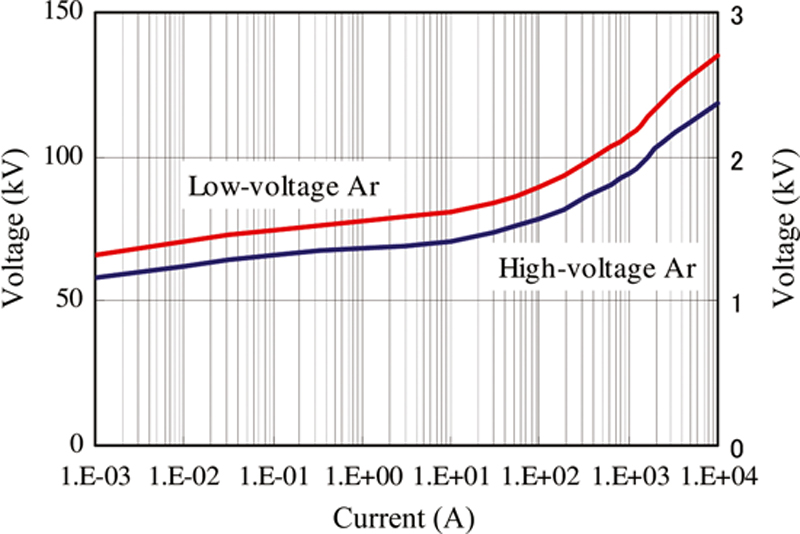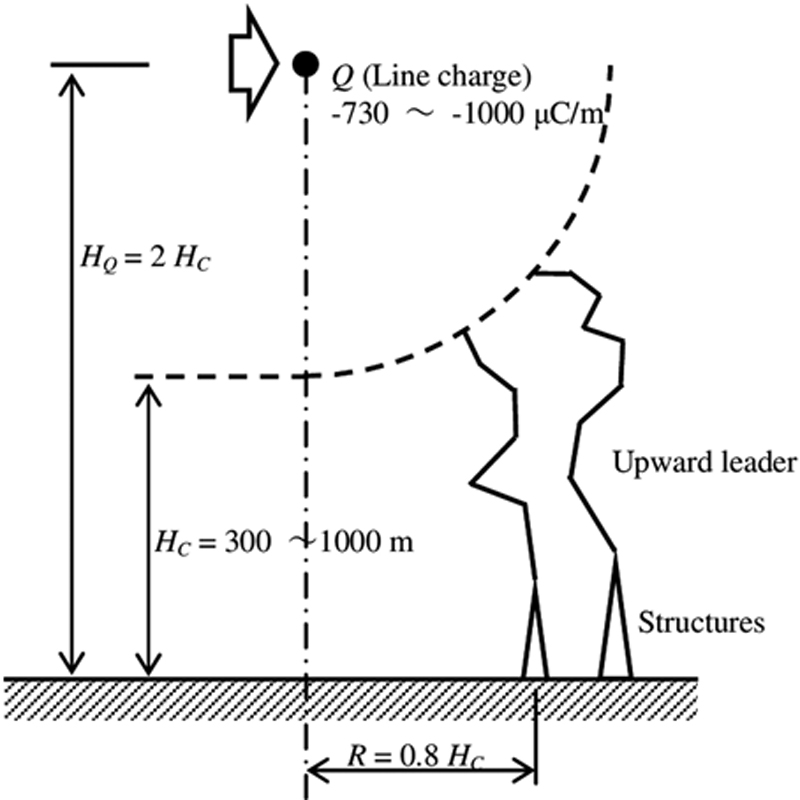Lightning protections of renewable energy generation systems
Abstract
The top of a blade of a wind turbine, with a couple of MW capacity, is more than 100 m high. In general, lightning tends to strike higher structures. Accordingly, lightning often strikes a wind tower or a blade. Most lightning currents have high amplitude and high frequency, and sometimes have large energy. The current generates a high voltage in the power apparatus and measurement and control systems in the wind turbine generation system, and causes damage to the apparatus, causing the system to malfunction. Distributed energy resources outside a house or building have a risk of lightning damage.
Keywords
8.1. Introduction

8.2. Lightning protection principle

8.2.1. Reduction
 (8.1)
(8.1)8.2.2. Suppression


(a) Simulation circuit for an SPD and an apparatus. (b) Lightning overvoltage at line end.

(a) Down conductor of the instrument is connected to the SPD, and is grounded at the SPD. (b) Down conductor of the instrument is connected to the SPD, and is grounded at the instrument. (c) Grounding of the SPD is isolated from that of the instrument.
8.2.3. Shielding

8.2.4. Lightning characteristics for lightning protection design


(1) Negative first strokes, (2) negative subsequent strokes, and (3) positive first strokes [21]
 (8.3)
(8.3)
(a) Observation point at Nadachi Wind Power Station. (b) Observation result of lightning current.

(a) Summer lightning. (b) Winter lightning.
Table 8.1
Parameters of Downward Negative Lightning [24]
| Parameters | Units | Sample Size | Exceeding Tabulated Value (%) | ||
| 95% | 50% | 5% | |||
Peak current (minimum 2 kA) First strokes Subsequent strokes |
kA |
101 135 |
14 4.6 |
30 12 |
80 30 |
Charge (total charge) First strokes Subsequent strokes Complete flash |
C |
93 122 94 |
1.1 0.2 1.3 |
5.2 1.4 7.5 |
24 11 40 |
Impulse charge (excluding continuing current) First strokes Subsequent strokes |
C |
90 117 |
1.1 0.22 |
4.5 0.95 |
20 4 |
Front duration (2 kA to peak) First strokes Subsequent strokes |
μs |
89 118 |
1.8 0.22 |
5.5 1.1 |
18 4.5 |
Maximum di/dt First strokes Subsequent strokes |
kA/μs |
92 122 |
5.5 12 |
12 40 |
32 120 |
Stroke duration (2 kA to half peak value on the tail) First strokes Subsequent strokes |
μs |
90 115 |
30 6.5 |
75 32 |
200 140 |
Action integral (∫i2dt) First strokes Subsequent strokes |
A2s |
91 88 |
6.0 x 103 5.5 x 102 |
5.5 x 104 6.0 x 103 |
5.5 x 105 5.2 x 104 |
| Time interval between strokes | ms | 133 | 7 | 33 | 150 |
Flash duration All flashes Excluding single-stroke flashes |
ms |
94 39 |
0.15 31 |
13 180 |
1100 900 |

where I0, η, τ1, n, and τ2 are constants, and are empirically determined.
8.2.5. IEC international standard [13–17]

Table 8.2
Definition of Lightning Protection Zones
|
Outer Zones |
|
| LPZ 0 | Zone where the threat is due to the unattenuated lightning electromagnetic field and where the internal systems may be subjected to full or partial lightning surge current. |
| LPZ 0A | Zone where the threat is due to the direct lightning flash and the full lightning electromagnetic field. The internal systems may be subjected to full or partial lightning surge current. |
| LPZ 0B | Zone protected against direct lightning flashes but where the threat is the full lightning electromagnetic field. The internal systems may be subjected to partial lightning surge currents. |
|
Inner Zones |
|
| LPZ 1 | Zone where the surge current is limited by current sharing and by SPDs at the boundary. Spatial shielding may attenuate the lightning electromagnetic field. |
| LPZ 2,...n | Zone where the surge current may be further limited by current sharing and by additional SPDs at the boundary. Additional spatial shielding may be used to further attenuate the lightning electromagnetic field. |

Table 8.3
Maximum Values of Lightning Parameters According to LPL
| First Short Positive Stroke | LPL | |||||
| Current Parameters | Symbol | Unit | I | II | III | IV |
| Peak current | I | kA | 200 | 150 | 100 | |
| Short stroke charge | Q short | C | 100 | 75 | 50 | |
| Specific energy | W/R | MJ/Ω | 10 | 5,6 | 2,5 | |
| Time parameters | T 1/T 2 | μs/μs | 10/350 | |||
| First Short Negative Strokea | LPL | |||||
| Peak current | I | kA | 100 | 75 | 50 | |
| Average steepness | di/dt | kA/μs | 100 | 75 | 50 | |
| Time parameters | T 1/T 2 | μs/μs | 1/200 | |||
| Subsequent Short Strokea | LPL | |||||
| Current Parameters | Symbol | Unit | I | II | III | IV |
| Peak current | I | kA | 50 | 37,5 | 25 | |
| Average steepness | di/dt | kA/μs | 200 | 150 | 100 | |
| Time parameters | T 1/T 2 | μs/μs | 0,25/100 | |||
| Long Stroke | LPL | |||||
| Current Parameters | Symbol | Unit | I | II | III | IV |
| Long stroke charge | Q long | C | 200 | 150 | 100 | |
| Time parameter | T long | s | 0,5 | |||
| Flash | LPL | |||||
| Current Parameters | Symbol | Unit | I | II | III | IV |
| Flash charge | Q flash | C | 300 | 225 | 150 | |

a The use of this wave shape concerns only calculations and not testing.
Table 8.4
Minimum Values of Lightning Parameters and Related Rolling Sphere Radius Corresponding to LPL
| Interception Criteria | LPL | |||||
| Symbol | Unit | I | II | III | IV | |
| Minimum peak current | I | kA | 3 | 5 | 10 | 16 |
| Rolling sphere radius | r | m | 20 | 30 | 45 | 60 |

8.3. Lightning protection for wind power generation systems
8.3.1. Lightning damage in wind power generation system

(a) Blade burnout; (b) blade burnout and wire melting.

8.3.2. Lightning protection methods for wind turbine

8.3.3. Grounding resistance

(a) Equivalent circuits of grounding resistance. (b) Transient response of grounding resistance.

(a) Configuration and dimension of grounding system of an actual wind turbine generator system. (b) Comparison of measured results of ground potential rise with simulation results using FDTD.
 (8.4)
(8.4)8.3.4. Lightning protection of blade using receptor [4,17]
8.3.5. Energy coordination of surge arrester/surge protective device [36]
 (8.5)
(8.5)
 (8.6)
(8.6)
 (8.7)
(8.7)
 (8.7)
(8.7)
 (8.8)
(8.8)

(a) Service line current (RD = 15 Ω); (b) Service line voltage (RW = 10 Ω).
8.4. Lightning protection of wind farms






(a) Nikaho wind park. (b) Taikoyama wind park.
8.5. Lightning protection for photovoltaic power generation systems
8.5.1. Lightning damage in photovoltaic system

8.5.2. Lightning protection against lightning overvoltages in photovoltaic systems
8.5.3. Direct lightning flash to photovoltaic system


